Earlier this year we covered 4-axis machining. Another popular high precision machine is a 5-axis machine. The higher the axis, the more advanced the machine is, meaning, the more opportunities you have when producing tools and parts in your shop.
What exactly is a 5-axis machine?
A 5-axis machine provides you with endless options when producing tools or parts. Despite its name, the 5-axis machine doesn’t actually add a true axis. Instead, it is just another type of rotation, allowing for free rotation in any direction. The main difference between a 5-axis machine and a 3-axis or 4-axis machine is exactly what the name entails. Although 3-axis machining is the most popular type of machining used when producing tools, there has been increased use recently in 4-axis and 5-axis machining.
Common misunderstandings related to 5-Axis machining
The 5-axis machine is certainly the most complex of the bunch, but the actual programming isn’t all that complicated. As long as you have a CAM system compatible with 5-axis machining, the actual programming isn’t as time consuming or complicated as you might think.
Which Type of Machining Do I Need?
Just because a 5-axis allows for more complex parts doesn’t necessarily mean it’s the tool you want to go with. Actually, only a few custom designs really require 5-axis machining. However, if you need incredibly precise, fast work with tight tolerances, then 5-axis is truly your best bet.
For the fast, simple products, use 3-axis machining. As you start to get more advanced, you’ll want to go to a 4-axis machine. These machines allow for very detailed work, engravings, complex drilling and milling, etc. When in doubt, just give us a call.
We can help…
Custom Tool & Grinding has state-of-the-art multi-axis capabilities designed to produce any type of custom tool to the best standards and fidelity. If you want your tool custom built, cut or ground, contact the experts at Custom Tool today.
